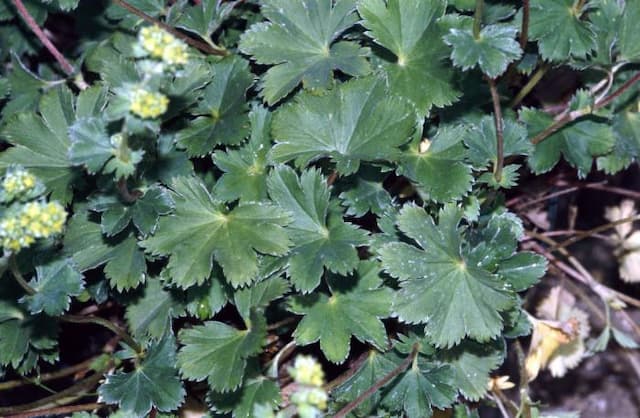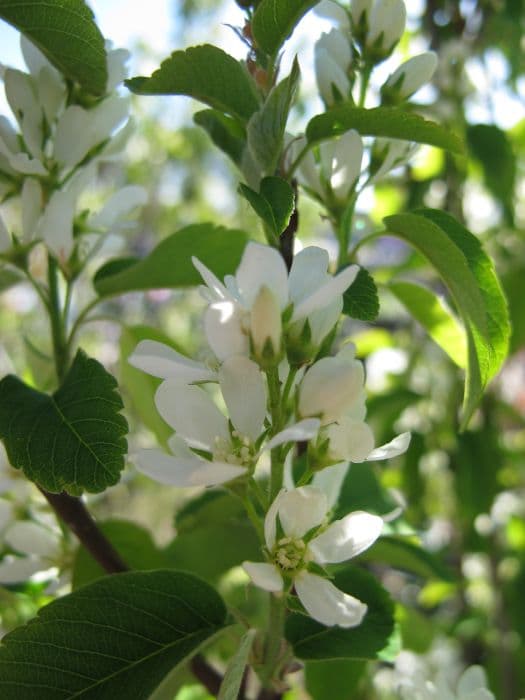Father Hugo's Rose Rosa xanthina f. hugonis

ABOUT
The plant commonly known as Father Hugo's Rose is a decidely eye-catching deciduous shrub. It is characterized by its arching branches that create a gracefully spreading form. The quite distinctive foliage comprises of pinnate leaves, each leaflet is lance-shaped with a serrated edge, exuding a fresh, bright green hue that adds a lively backdrop to the blossoms. Resplendent in spring, the plant becomes adorned with a profusion of small, single flowers. Each blossom displays a rich, golden-yellow color, with a simple form that consists of five petals circling around a center of prominent golden stamens. These flowers are lightly scented, presenting a soft fragrance that gently perfumes the surrounding air. With the change of seasons, once the blooming spectacle completes, the plant develops small, oval-shaped fruits known as hips. These bear a reddish to orange color, contributing additional interest to the plant's appearance as the foliage turns into delightful autumnal colors before falling away as winter approaches. Overall, the visual allure of Father Hugo's Rose lies in its bountiful yellow blooms, its graceful structure, and its ability to bring a cheerful presence in the landscape across different seasons.
About this plant
 Names
NamesFamily
Rosaceae
Synonyms
Father Hugo's Rose, Golden Rose of China, Hugh's Rose
Common names
Rosa hugonis, Rosa xanthina var. hugonis
 Toxicity
ToxicityTo humans
The plant commonly known as Father Hugo's Rose is not widely recognized as having significant toxicity to humans. Human poisoning from ingesting parts of roses is rare, as these plants do not typically contain toxins at levels that are dangerous to people. In general, roses are considered to be safe around humans, and there is not a well-documented history of them causing serious adverse reactions upon ingestion. However, as with any plant material, individual sensitivities or allergic reactions may occur, and ingesting large amounts of plant material can cause gastrointestinal discomfort due to the mechanical irritation or indigestible fiber content.
To pets
Father Hugo's Rose is generally considered non-toxic to pets. Roses, in general, do not contain compounds that are known to poison animals, so ingestion of this plant is not expected to cause serious harm to your pets. However, as with ingestion by humans, pets that consume a large amount of plant material may experience mild stomach upset due to the mechanical effects of the fibers and thorns that can cause irritation. It is also possible for pets, especially dogs and cats, to experience mild reactions if they are particularly sensitive to plant materials. If you suspect your pet has ingested a significant amount of this or any plant, it is always a good idea to consult a veterinarian.
 Characteristics
CharacteristicsLife cycle
Perennials
Foliage type
Deciduous
Color of leaves
Green
Flower color
Yellow
Height
4-6 feet [1.2-1.8 meters]
Spread
4-6 feet [1.2-1.8 meters]
Plant type
Shrub
Hardiness zones
6
Native area
China
Benefits
 General Benefits
General Benefits- Ornamental value: The plant, commonly known as Father Hugo's rose, has bright yellow flowers which add aesthetic appeal to gardens and landscapes.
- Habitat support: It offers a natural habitat and food source for pollinators such as bees and butterflies.
- Shade creation: As a large shrub, it can provide shade for smaller plants or garden areas once fully grown.
- Privacy screen: When planted in rows or as hedges, Father Hugo's rose can serve as a privacy screen while adding beauty to the area.
- Erosion control: The plant's root system can help stabilize soil and reduce erosion.
- Cultural symbolism: Roses often carry symbolic meanings in different cultures, which can make them popular choices for gardens with thematic designs.
- Low maintenance: Father Hugo's rose is known to be relatively hardy and requires minimal maintenance once established.
 Medical Properties
Medical Properties- Anti-inflammatory: Rosa xanthina f. hugonis has been used in traditional medicine for its potential anti-inflammatory properties.
- Antioxidant: The plant contains antioxidants that may help protect cells from damage.
- Antimicrobial: It may have antimicrobial activities against certain bacteria and fungi.
- Antidepressant effects: Some studies suggest it might have mood-elevating properties.
- Heart health: There are indications that it could have benefits for heart health, possibly by improving circulation or reducing oxidative stress.
 Air-purifying Qualities
Air-purifying QualitiesThis plant is not specifically known for air purifying qualities.
 Other Uses
Other Uses- Perfumery: The fragrance of Rosa hugonis flowers can be used in the production of perfumes and scented oils.
- Culinary Use: The petals can be used for flavoring foods or as a colorful garnish in salads and desserts.
- Dyeing: The petals of Rosa hugonis can be used to create natural dyes for fabrics or crafts.
- Botanical Illustration: The distinct yellow flowers make it a popular subject for botanical artists and illustrators.
- Garden Design: Its unique yellow coloration and early spring bloom can be used to create thematic garden designs or to add a splash of color in a floral landscape.
- Photography Prop: This rose can be used as a beautiful natural prop in still-life photography or as a subject for garden photographers.
- Educational Aid: It can be utilized as a teaching tool in horticultural studies due to its distinct characteristics and hardiness.
- Literary Inspiration: The striking appearance may inspire poets and writers as a symbol in their work, representing joy or spring.
- Floral Displays: The branches with their yellow blooms can be used for creating elegant floral displays and arrangements for various events.
- Companion Planting: In gardens, Rosa hugonis can be used as a companion plant to attract beneficial insects and promote biodiversity.
Interesting Facts
 Feng Shui
Feng ShuiThe plant Father Hugo's Rose is not used in Feng Shui practice.
 Zodiac Sign Compitability
Zodiac Sign CompitabilityFather Hugo's Rose is not used in astrology practice.
 Plant Symbolism
Plant Symbolism- Love: As a member of the rose family, Rosa xanthina f. hugonis commonly symbolizes love and affection, embodying the classic meaning attributed to roses.
- Beauty: This rose, with its beautiful and distinct flowers, traditionally represents beauty and perfection, echoing the universal admiration for the rose's form.
- Friendship: While red roses are often associated with romantic love, yellow roses like Rosa xanthina f. hugonis can symbolize friendship and joy in relationships.
- Optimism: The bright, yellow flowers of this rose are suggestive of sunshine and positivity, thus it often stands for optimism and hope.
- New Beginnings: The blooming of any rose, including Rosa xanthina f. hugonis, represents new beginnings and the start of something fresh, making it a fitting symbol for occasions like weddings or graduations.
- Secrecy: Historically, roses have been used to signify secrecy with the term "sub rosa," meaning under the rose, dating back to ancient times as a symbol of confidentiality.
 Water
WaterGolden Rose (Rosa xanthina f. hugonis) should be watered deeply once a week, ensuring that the water penetrates the soil to a depth of about 18 inches. During hot or dry spells, it may be necessary to increase the frequency to twice a week. It's essential to avoid overwatering, as this can lead to root rot. Typically, 1-2 gallons per plant per watering session are adequate, depending on soil type and weather conditions. Monitor the soil moisture regularly and adjust the watering schedule accordingly, especially as the seasons change.
 Light
LightGolden Rose thrives best in full sun conditions, receiving at least six hours of direct sunlight daily. The ideal spot for this plant is in an area where it can enjoy uninterrupted sunshine throughout the day, which encourages healthy growth and abundant flowering. Slightly dappled afternoon shade can be beneficial in extremely hot climates to prevent scorched leaves.
 Temperature
TemperatureGolden Rose is robust and can tolerate a wide range of temperatures. The plant performs well in temperatures between 60°F to 70°F but can survive temperature extremes from just above freezing, around 35°F, up to about 90°F. It is essential to protect the plant from frost, which can damage young growth and flower buds.
 Pruning
PruningPrune Golden Rose in late winter or early spring, before new growth starts, to remove dead or diseased wood and to shape the plant. Pruning encourages healthy growth and increases air circulation, which can reduce the risk of disease. Pruning should be done annually, cutting back about one-third of the older canes to promote rejuvenation.
 Cleaning
CleaningAs needed
 Soil
SoilThe Father Hugo Rose prefers well-draining loamy soil enriched with organic matter. A soil pH between 6.0 and 7.0 is ideal. A mixture of two parts loam, one part peat moss, and one part compost with a handful of bone meal works well for this plant.
 Repotting
RepottingFather Hugo Rose typically does not require frequent repotting, as it is a shrub that thrives outdoors. However, if grown in containers, repotting every 2-3 years in the spring can be beneficial.
 Humidity & Misting
Humidity & MistingFather Hugo Rose is tolerant of a wide range of humidity levels and does not require any special humidity considerations beyond the natural outdoor environment.
 Suitable locations
Suitable locationsIndoor
Ensure bright light, occasional pruning, and monitor for pests.
Outdoor
Plant in sun, provide space for air, and water deeply.
Hardiness zone
4-9 USDA
 Life cycle
Life cycleRosa xanthina f. hugonis, commonly known as Father Hugo's Rose, begins its life cycle with seed germination in spring, which requires a period of stratification to break dormancy. Following germination, the seedlings grow into young plants with characteristic pinnate leaves and start developing a root system. As they mature, these roses enter a vegetative stage, forming thorny stems and compound leaves. Upon reaching maturity, Father Hugo's Rose typically blooms in late spring to early summer, presenting clusters of single, pale yellow flowers. After pollination, which can be facilitated by insects, the plant develops hips (fruit) containing seeds, thus completing its reproductive cycle. In the dormant season during fall and winter, the plant conserves energy and prepares for the next growth cycle.
 Propogation
PropogationPropogation time
Early spring
Propogation: The Rosa xanthina f. hugonis, commonly known as Father Hugo's Rose, is predominantly propagated through softwood cuttings. This method is most successful when carried out in late spring or early summer as this is when the plant is actively growing and the stems are tender and easy to cut. To propagate Father Hugo's Rose using softwood cuttings, one should select a healthy, disease-free shoot and cut a 4 to 6 inch (approximately 10 to 15 centimeters) piece from the tip. The cutting should include at least two or three sets of leaves. The lower leaves are then removed and the cut end is dipped in rooting hormone before being placed in a well-drained soil mix. It's beneficial to maintain high humidity around the cuttings, and it typically takes a few weeks for roots to develop.









